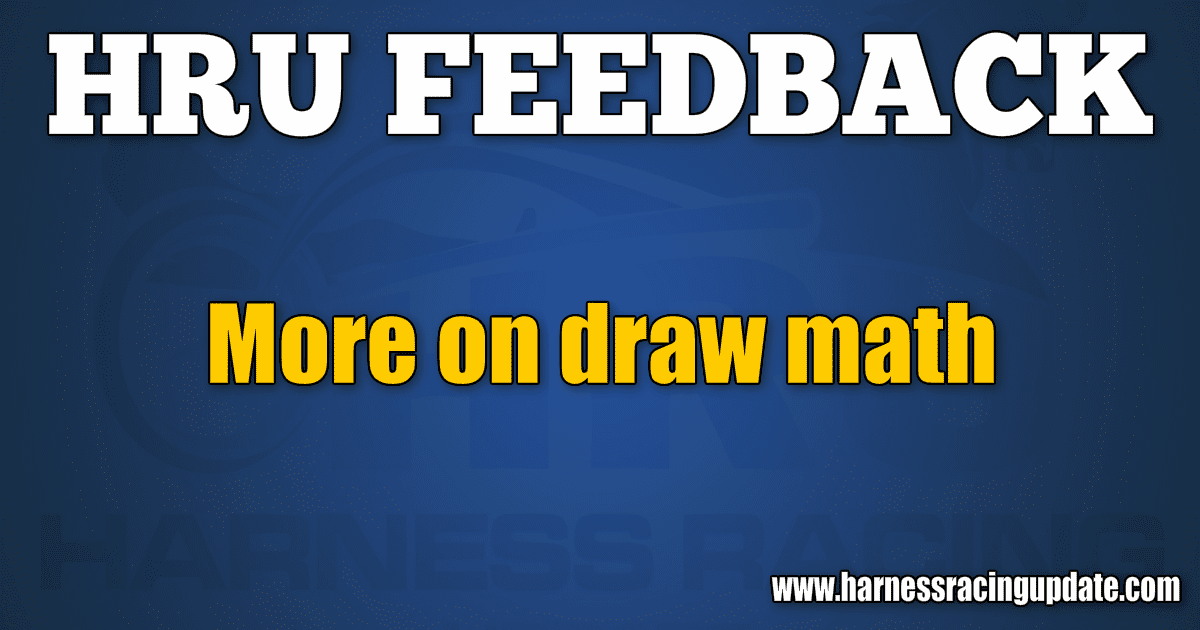HRU Feedback (2018-10-21)
More math on draw probability
This is in response to Phil Sporn’s reply as to the odds of three horses drawing into the same race (full story here). He is correct that there are only four possibilities, but the fallacy in his argument is that each probability has an equal chance of happening. Also, the amount of horses in each division does play a role as to the eventual outcome that can be seen from the calculations below. The odds of three horses ending up in the same division in two eight-horse fields are 20 per cent or 1 in 5 which is 4 to 1 odds. The calculation: the first horse draws into either div. 1 or 2. There are 7 slots left in that division and 8 in the other so that is 7 out of 15. Then there are 6 left out of 14. The odds of both occurring are 7/15 x 6/14 which is 42/210=1/5. I know this is not earth shattering, but interesting nonetheless.
— Eric Cherry / Boca Raton, FL
Even more math
Not to beat this topic to death, but I would like to respond to Phil Sporn’s response to Pete Goulazian’s letter concerning the odds of Manchego, Atlanta, and Plunge Blue Chip all drawing into the same division of the two splits of the filly Kentucky Futurity.
I believe that the odds are 25 per cent (1:4), not the 50 per cent (1:1) indicated in Sporn’s letter nor the 700:1 odds against indicated in Goulazian’s letter.
Sporn’s analysis is close to being correct but does not include the fact that, a priori, there are actually six combinations of ways that you can have one filly in one division and the other two fillies in another division as indicated in the generic analysis below for three different horses (A, B and C).
They can be distributed into the two divisions as follows:
DIVISION 1 DIVISION 2
None ABC
A BC
B AC
C AB
BC A
AC B
AB C
ABC None
Thus, since two of the eight combinations have all three horses in the same division, the odds would be two out of eight (1:4) or 25 per cent. Note that it does not matter in these calculations as to the order in which the horses are drawn.
I also agree with Sporn that the analysis would not change if there were eight or even 88 entries in the race. If the number of horses in each division were unequal (i.e., 8 vs 7), the odds that a given filly might appear in one division or the other would be slightly different, but the overall odds that all three fillies might appear in the same division should not change.
As an aside, the odds would drop to 11.1 per cent (1:9) if there are three divisions of a race (three out of the 27 possible combinations would contain all three horses).
Finally, I should disclose that I used to know Phil Sporn from when I was a minor stakeholder in a number of horse partnerships that he helped broker many years ago. Hello Phil.
— Michael Swerdloff / Florham Park, NJ
More changes needed
Reading HRU Oct 14 Feedback column William Waters spoke about changes he would like to see from the Red Mile and I would have to agree with what his concerns were and yes it does appear as an insiders’ game. I wrote in this same column about how years ago I approached a WEG executive with years of statistics on the importance of timing and printing in the program the opening 1/8th and results. This, I was told, was something that needed to be brought to Standardbred Canada as they are the people that handle the charts and past performances. When I approached them, I was told it would be too much trouble to accommodate the changes, yet on WEG’s broadcasts they do time and show on screen the opening 1/8, well done WEG. Another improvement was to indicate on each program page the horses that were either rising or dropping in class, this was for new customers to help them decipher the program pages, again nothing happened. How can the industry even talk about being self-sustaining when they need to have new customers yet do nothing about it? Doing nothing has been for years the norm and maybe the Ontario government should put conditions to their handouts for the industry and that is if they can’t provide customers with total transparency then no funding. We can put a man on the moon and we can give birth through the use of computers and yet the keeper of statistical information for the industry in Canada says it’s too much of a bother to make changes or it can’t be done, amazing.
— Bob Adams / London, ON

















